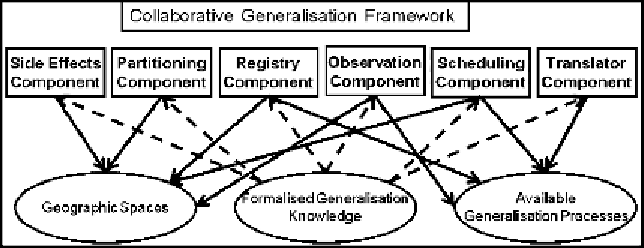Geoscience Reference
In-Depth Information
Figure 1:
The main Components (rectangles) and Resources (ellipses) of a Collaborative
Generalisation framework and how the components act on the resources (plain arrows).
Dashed arrows show that formal knowledge is used by each component.
Within the CG framework, we developed the CollaGen model that imple-
ments all the aspects of collaborative generalisation defined in
Figure 1
.
The next parts describe how each aspect is managed in CollaGen.
3- The CollaGen Model
3.1 Automatic Generalisation Processes
CG consists in making several available automatic processes collaborate to
optimise the entire map generalisation. Thus, we consider as an available
automatic generalisation process, any process that can be triggered on geo-
graphic data from the software platform the CG framework is developed
on. A process is a computer program that automatically triggers generalisa-
tion operator (e.g. simplification, displacement...) sequences on geographic
objects. For instance, in CollaGen, developed on a research platform
(Renard et al. 2010), AGENT (Ruas 1999), CartACom (Duchêne 2004),
GAEL (Gaffuri 2007), Least Squares (Harrie and Sarjakoski 2002) or road
selection processes are implemented and thus available for collaboration.
Processes published as web services (Regnauld 2007, Neun et al. 2008)
could also be considered as available processes.

